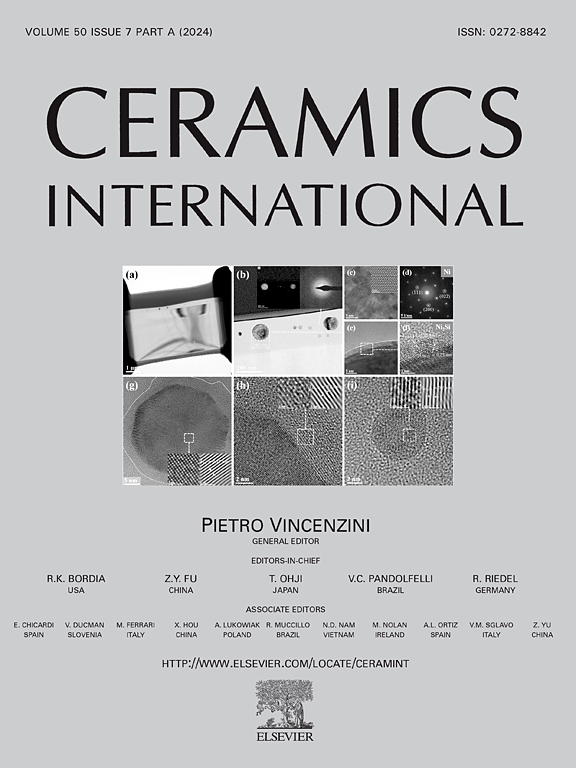Co-electrospun SiC nanoparticle-decorated SiC fiber hybrid materials towards highly effective and broadband electromagnetic attenuation performance
IF 5.6
2区 材料科学
Q1 MATERIALS SCIENCE, CERAMICS
引用次数: 0
Abstract
High-temperature resistant performance for thermal end components has always been a key development direction in advanced microwave absorption materials. SiC fibrous materials could be served as the ideal candidate to meet the challenge of both lightweight and high temperature resistance. However, the relatively weak microwave attenuation capacity of pure SiC fibers greatly limit the further application. Herein, highly crystallized SiC nanoparticles (SiCnp) were decorated into the SiC fiber (SiCf) matrix via co-electrospinning and high temperature pyrolysis. The resultant SiCnp@SiCf composite fiber material possesses abundant heterogeneous interfaces to fascinate the dielectric loss, as well as the enhancement of conductivity loss. The optimized SiCnp@SiCf sample pyrolyzed at 1300 °C exhibits a minimal reflection loss (RLmin) of −57.04 dB at 6.84 GHz, and the effective absorption bandwidth (EAB) reaches as wide as 7.5 GHz at 2.7 mm. With the filler content of only 10 wt%, the prepared SiCnp@SiCf hybrid material could be applied as highly efficient and broadband ceramic microwave absorber.
共静电纺碳化硅纳米颗粒修饰碳化硅纤维杂化材料的高效宽带电磁衰减性能
热端元件的耐高温性能一直是先进微波吸收材料的关键发展方向。SiC纤维材料可以作为满足轻量化和耐高温挑战的理想候选材料。然而,纯SiC光纤的微波衰减能力相对较弱,极大地限制了其进一步应用。本文通过共静电纺丝和高温热解将高结晶的SiC纳米颗粒(SiCnp)装饰到SiC纤维(SiCf)基体中。由此制备的SiCnp@SiCf复合纤维材料具有丰富的非均相界面,可以减小介质损耗,同时提高电导率损耗。优化后的SiCnp@SiCf样品在1300℃热解时,在6.84 GHz处的反射损耗最小(RLmin)为- 57.04 dB,在2.7 mm处的有效吸收带宽(EAB)达到7.5 GHz。制备的SiCnp@SiCf杂化材料在掺量仅为10 wt%的情况下,可作为高效宽带陶瓷微波吸收体。
本文章由计算机程序翻译,如有差异,请以英文原文为准。
求助全文
约1分钟内获得全文
求助全文
来源期刊

Ceramics International
工程技术-材料科学:硅酸盐
CiteScore
9.40
自引率
15.40%
发文量
4558
审稿时长
25 days
期刊介绍:
Ceramics International covers the science of advanced ceramic materials. The journal encourages contributions that demonstrate how an understanding of the basic chemical and physical phenomena may direct materials design and stimulate ideas for new or improved processing techniques, in order to obtain materials with desired structural features and properties.
Ceramics International covers oxide and non-oxide ceramics, functional glasses, glass ceramics, amorphous inorganic non-metallic materials (and their combinations with metal and organic materials), in the form of particulates, dense or porous bodies, thin/thick films and laminated, graded and composite structures. Process related topics such as ceramic-ceramic joints or joining ceramics with dissimilar materials, as well as surface finishing and conditioning are also covered. Besides traditional processing techniques, manufacturing routes of interest include innovative procedures benefiting from externally applied stresses, electromagnetic fields and energetic beams, as well as top-down and self-assembly nanotechnology approaches. In addition, the journal welcomes submissions on bio-inspired and bio-enabled materials designs, experimentally validated multi scale modelling and simulation for materials design, and the use of the most advanced chemical and physical characterization techniques of structure, properties and behaviour.
Technologically relevant low-dimensional systems are a particular focus of Ceramics International. These include 0, 1 and 2-D nanomaterials (also covering CNTs, graphene and related materials, and diamond-like carbons), their nanocomposites, as well as nano-hybrids and hierarchical multifunctional nanostructures that might integrate molecular, biological and electronic components.
 求助内容:
求助内容: 应助结果提醒方式:
应助结果提醒方式:


